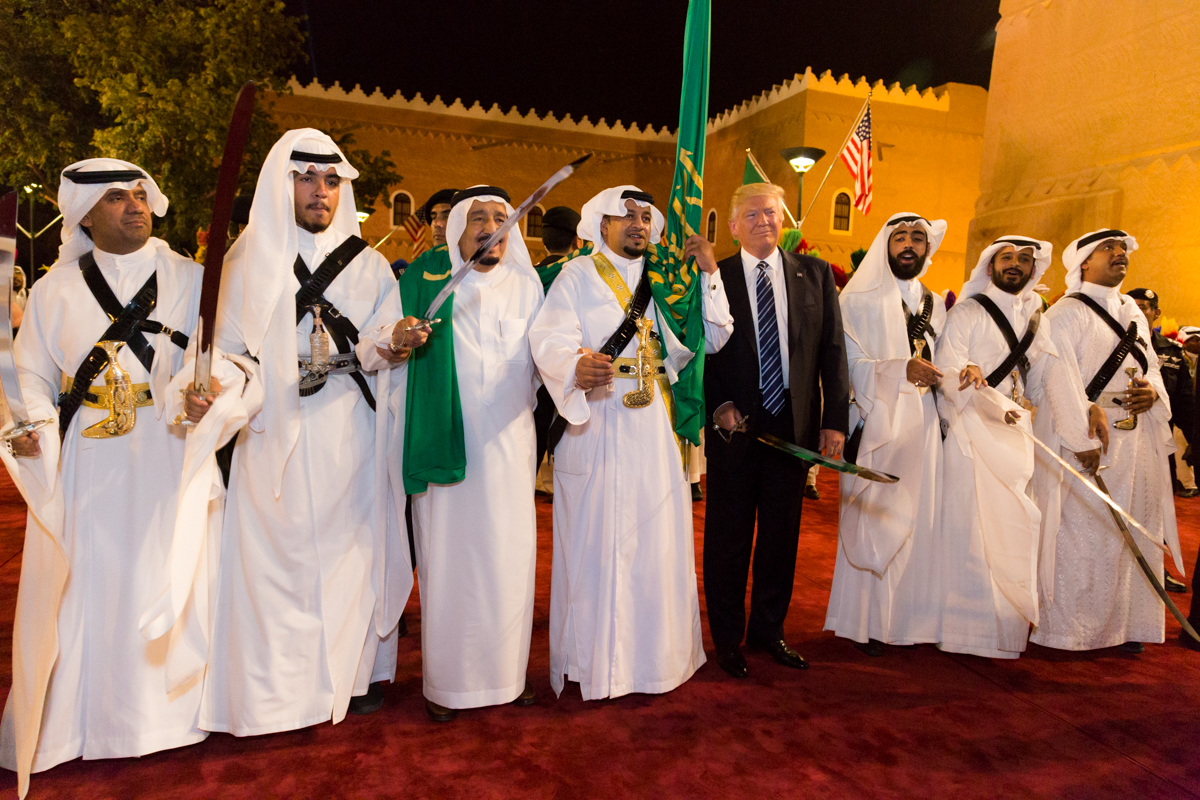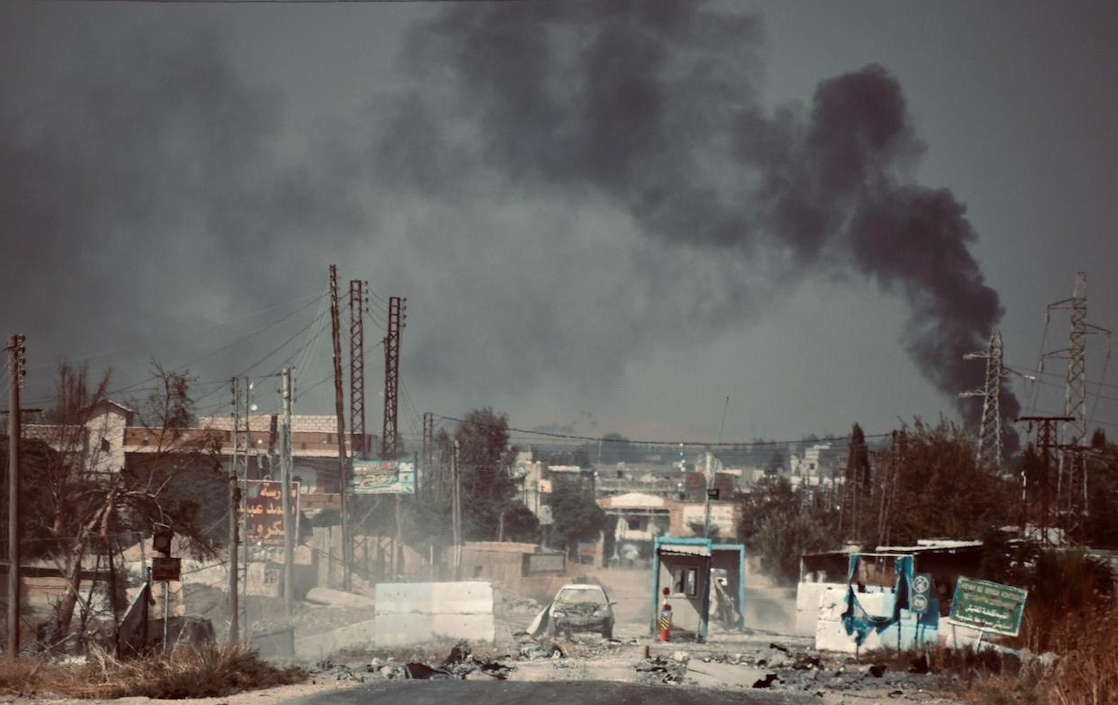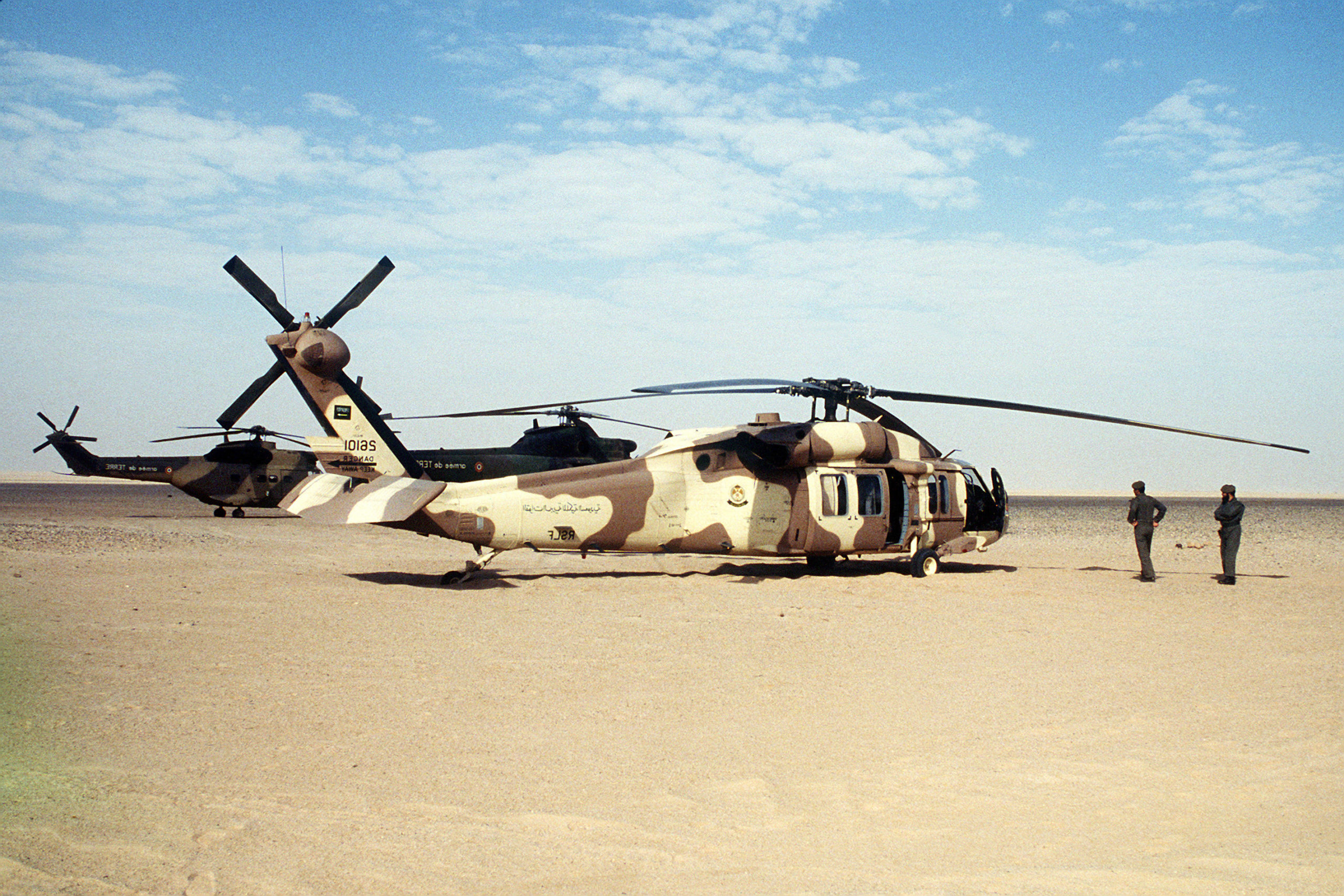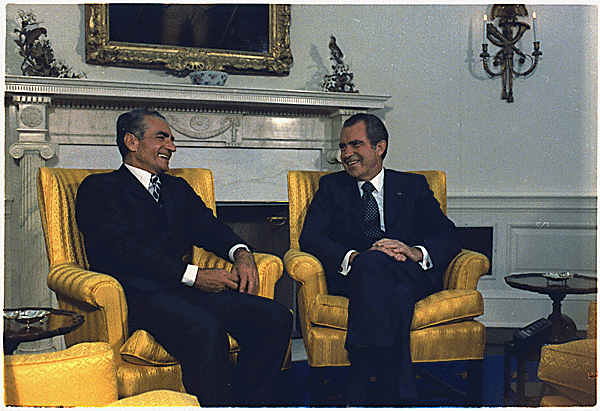William Hartung reviews the 50-year history of U.S. dominance of the Middle Eastern arms trade.

President Donald Trump visits King Salman bin Abdulaziz Al Saud of Saudi Arabia, May, 2017, in Riyadh, Saudi Arabia. (White House/Shealah Craighead)
By William Hartung
TomDispatch.com
 It’s no secret that Donald Trump is one of the most aggressive arms salesmen in history. How do we know? Because he tells us so at every conceivable opportunity. It started with his much exaggerated “$110 billion arms deal” with Saudi Arabia, announced on his first foreign trip as president. It continued with his White House photo op with Crown Prince Mohammed bin Salman in which he brandished a map with a state-by-state rundown of American jobs supposedly tied to arms sales to the kingdom. And it’s never ended. In these years in office, in fact, the president has been a staunch advocate for his good friends at Boeing, Lockheed Martin, Raytheon, and General Dynamics — the main corporate beneficiaries of the U.S.-Saudi arms trade (unlike the thousands of American soldiers the president recently sent into that country’s desert landscapes to defend its oil facilities).
It’s no secret that Donald Trump is one of the most aggressive arms salesmen in history. How do we know? Because he tells us so at every conceivable opportunity. It started with his much exaggerated “$110 billion arms deal” with Saudi Arabia, announced on his first foreign trip as president. It continued with his White House photo op with Crown Prince Mohammed bin Salman in which he brandished a map with a state-by-state rundown of American jobs supposedly tied to arms sales to the kingdom. And it’s never ended. In these years in office, in fact, the president has been a staunch advocate for his good friends at Boeing, Lockheed Martin, Raytheon, and General Dynamics — the main corporate beneficiaries of the U.S.-Saudi arms trade (unlike the thousands of American soldiers the president recently sent into that country’s desert landscapes to defend its oil facilities).
All the American arms sales to the Middle East have had a severe and lasting set of consequences in the region in, as a start, the brutal Saudi/United Arab Emirates war in Yemen, which has killed thousands of civilians via air strikes using U.S. weaponry and pushed millions of Yemenis to the brink of famine. And don’t forget the recent Turkish invasion of Syria in which both the Turkish forces and the Kurdish-led militias they attacked relied heavily on U.S.-supplied weaponry.

Syrian town of Ras al-Ayn on Oct. 11, 2019 after Turkish airstrikes. (A. Lourie, Wikimedia Commons)
Trump has made it abundantly clear that he cares far more about making deals for that weaponry than who uses any of it against whom. It’s important to note, however, that, historically speaking, he’s been anything but unique in his obsession with promoting such weapons exports (though he is uniquely loud about doing so).
Despite its supposedly strained relationship with the Saudi regime, the Obama administration, for example, still managed to offer the royals of that kingdom a record $136 billion in U.S. weapons between 2009 and 2017. Not all of those offers resulted in final sales, but striking numbers did. Items sold included Boeing F-15 combat aircraft and Apache attack helicopters, General Dynamics M-1 tanks, Raytheon precision-guided bombs, and Lockheed Martin bombs, combat ships, and missile defense systems. Many of those weapons have since been put to use in the war in Yemen.
To its credit, the Obama administration did at least have an internal debate on the wisdom of continuing such a trade. In December 2016, late in his second term, the president finally did suspend the sale of precision-guided bombs to the Royal Saudi Air Force due to a mounting toll of Yemeni civilian deaths in U.S.-supplied Saudi air strikes. This was, however, truly late in the game, given that the Saudi regime first intervened in Yemen in March 2015 and the slaughter of civilians began soon after that.
By then, of course, Washington’s dominance of the Mideast arms trade was taken for granted, despite an occasional large British or French deal like the scandal-plagued Al Yamamah sale of fighter planes and other equipment to the Saudis, the largest arms deal in the history of the United Kingdom. According to the Stockholm International Peace Research Institute, from 2014 to 2018 the United States accounted for more than 54 percent of known arms deliveries to the Middle East. Russia lagged far behind with a 9.5 percent share of the trade, followed by France (8.6 percent), England (7.2 percent), and Germany (4.6 percent). China, often cited as a possible substitute supplier, should the U.S. ever decide to stop arming repressive regimes like Saudi Arabia, came in at less than 1 percent.
The U.S. government’s stated rationales for pouring arms into that ever-more-embattled region include: building partnerships with countries theoretically willing to fight alongside U.S. forces in a crisis; swapping arms for access to military bases in Kuwait, the United Arab Emirates, Qatar, and other Persian Gulf states; creating “stability” by building up allied militaries to be stronger than those of potential adversaries like Iran; and generating revenue for U.S. weapons contractors, as well as jobs for American workers. Of course, such sales have indeed benefited those contractors and secured access to bases in the region, but when it comes to promoting stability and security, historically it’s been another story entirely.

Military personnel stand near a Saudi Arabian land army Sikorsky S-70 helicopter during Operation Desert Shield. (USAF/ H. H. Deffner, Wikimedia Commons)
The Nixon Doctrine
Washington’s role as the Middle East’s top arms supplier has its roots in remarks made by Richard Nixon half a century ago on the island of Guam. It was the Vietnam War era and the president was on his way to South Vietnam. Casualties there were mounting rapidly with no clear end to the conflict in sight. During that stopover in Guam, Nixon assured reporters accompanying him that it was high time to end the practice of sending large numbers of U.S troops to overseas battlefields. To “avoid another war like Vietnam anywhere in the world,” he was instead putting a new policy in place, later described by a Pentagon official as “sending arms instead of sending troops.”
The core of what came to be known as the Nixon Doctrine was the arming of regional surrogates, countries with sympathetic rulers or governments that could promote U.S. interests without major contingents of the American military being on hand. Of such potential surrogates at that moment, the most important was the Shah of Iran, with whom a CIA-British intelligence coup replaced a civilian government back in 1953 and who proved to have an insatiable appetite for top-of-the-line U.S. weaponry.

Shah of Iran, left, with President Richard Nixon, in the Oval Office, 1973. (White House/Wikimedia Commons)
The Shah’s idea of a good time was curling up with the latest copy of Aviation Week and Space Technology and perusing glossy photos of combat planes. Egged on by the Nixon administration, his was the first and only country to buy the costly Grumman F-14 combat aircraft at a time when that company desperately needed foreign sales to bolster the program. And the Shah put his U.S.-supplied weapons to use, too, helping, for instance, to put down an anti-government uprising in nearby Oman (a short skip across the Persian Gulf), while repressing his own population at the same time.
In the Nixon years, Saudi Arabia, too, became a major weapons client of Washington, not so much because it feared its regional neighbors then, but because it had seemingly limitless oil funds to subsidize U.S. weapons makers at a time when the Pentagon budget was beginning to be reduced. In addition, Saudi sales helped recoup some of the revenue streaming out of the U.S. to pay for higher energy prices exacted by the newly formed OPEC oil cartel. It was a process then quaintly known as “recycling petrodollars.”
Carter’s Quest for Restraint
The freewheeling arms trade of the Nixon years eventually prompted a backlash. In 1976, for the first (and last) time, a presidential candidate — Jimmy Carter — made reining in the arms trade a central theme of his 1976 campaign for the White House. He called for imposing greater human-rights scrutiny on arms exports, reducing the total volume of arms transfers, and initiating talks with the Soviet Union on curbing sales to regions of tension like the Middle East.
Meanwhile, members of Congress, led by Democratic Senators Gaylord Nelson and Hubert Humphrey, felt that it was long past time for Capitol Hill to have a role in decision-making when it came to weapons sales. Too often congressional representatives found out about major deals only by reading news reports in the papers long after such matters had been settled. Among the major concerns driving their actions: the Nixon-era surge of arms sales to Saudi Arabia, then still an avowed adversary of Israel; the use of U.S.-supplied weapons by both sides in the Greek-Turkish conflict over the island of Cyprus; and covert sales to extremist right-wing forces in southern Africa, notably the South African-backed Union for the Total Independence of Angola. The answer was the passage of the Arms Export Control Act of 1978, which required that Congress be notified of any major sales in advance and asserted that it had the power to veto any of them viewed as dangerous or unnecessary.
As it happened, though, neither President Carter’s initiative nor the new legislation put a significant dent in such arms trafficking. In the end, for instance, Carter decided to exempt the Shah’s Iran from serious human-rights strictures and his hardline national security advisor, Zbigniew Brzezinski, undercut those talks with the Soviet Union on reducing arms sales.
Carter also wanted to get the new Rapid Deployment Force (RDF) he established —which eventually morphed into the U.S. Central Command — access to military bases in the Persian Gulf region and was willing to use arms deals to do so. The RDF was to be the centerpiece of the Carter Doctrine, a response to the 1979 Soviet invasion of Afghanistan and the fall of the Shah of Iran. As the president made clear in his 1980 State of the Union address: “An attempt by any outside forces to gain control of the Persian Gulf region will be regarded as an assault on the vital interests of the United States. It will be repelled by use of any means necessary, including the use of force.” Selling arms in the region would prove a central pillar of his new doctrine.
Meanwhile, most major sales continued to sail through Congress with barely a discouraging word.
Who Armed Saddam Hussein?

President Ronald Reagan with, from right: Caspar Weinberger, George Shultz, Ed Meese and Don Regan, discussing the president’s remarks on the Iran-Contra affair, Oval Office, November 1986. (White House/Wikimedia Commons)
While the volume of those arms sales didn’t spike dramatically under President Ronald Reagan, his determination to weaponize anti-communist “freedom fighters” from Afghanistan to Nicaragua sparked the Iran-Contra scandal. At its heart lay a bizarre and elaborate covert effort led by National Security Council staff member Oliver North and a band of shadowy middlemen to supply U.S. weapons to the hostile regime of Ayatollah Khomeini in Iran. The hope was to gain Tehran’s help in freeing U.S. hostages in Lebanon. North and company then used the proceeds from those sales to arm anti-government Contra rebels in Nicaragua in violation of an explicit Congressional ban on such aid.
Worse yet, the Reagan administration transferred arms and provided training to extremist mujahedeen factions in Afghanistan, acts which would, in the end, help arm groups and individuals that later formed al-Qaeda (and similar groups). That would, of course, prove a colossal example of the kind of blowback that unrestricted arms trading too often generates.
Even as the exposure of North’s operation highlighted U.S. arms transfers to Iran, the Reagan administration and the following one of President George H.W. Bush would directly and indirectly supply nearly half a billion dollars’ worth of arms and arms-making technology to Iran’s sworn enemy, Iraqi autocrat Saddam Hussein. Those arms would bolster Saddam’s regime both in its war with Iran in the 1980s and in its 1991 invasion of Kuwait that led to Washington’s first Gulf War. The U.S. was admittedly hardly alone in fueling the buildup of the Iraqi military. All five permanent members of the United Nations Security Council (the U.S., the Soviet Union, France, the United Kingdom, and China) provided weapons or weapons technology to that country in the run-up to its intervention in Kuwait.
The embarrassment and public criticism generated by the revelation that the U.S. and other major suppliers had helped arm the Iraqi military created a new opening for restraint. Leaders in the U.S., Great Britain, and other arms-trading nations pledged to do better in the future by increasing information about and scrutiny of their sales to the region. This resulted in two main initiatives: the United Nations arms trade register, where member states were urged to voluntarily report their arms imports and exports, and talks among those five Security Council members (the largest suppliers of weapons to the Middle East) on limiting arms sales to the region.
However, the P-5 talks, as they were called, quickly fell apart when China decided to sell a medium-range missile system to Saudi Arabia and President Bill Clinton’s administration began making new regional weapons deals at a pace of more than $1 billion per month while negotiations were underway. The other suppliers concluded that the Clinton arms surge violated the spirit of the talks, which soon collapsed, leading in the presidency of George W. Bush to a whole new Iraqi debacle.
The most important series of arms deals during the George W. Bush years involved the training and equipping of the Iraqi military in the wake of the invasion of Iraq and the overthrow of Saddam Hussein. But $25 billion in U.S. arms and training was not enough to create a force capable of defeating the modestly armed militants of ISIS, when they swept into northern Iraq in 2014 and captured large swaths of territory and major cities, including Mosul. Iraqi security forces, short on food and equipment due to corruption and incompetence, were also short on morale, and in some cases virtually abandoned their posts (and U.S. weaponry) in the face of those ISIS attacks.
The Addiction Continues
Donald Trump has carried on the practice of offering weaponry in quantity to allies in the Middle East, especially the Saudis, though his major rationale for the deals is to generate domestic jobs and revenues for the major weapons contractors. In fact, investing money and effort in almost anything else, from infrastructure to renewable energy technologies, would produce more jobs in the U.S. No matter though, the beat just goes on.
One notable development of the Trump years has been a revived congressional interest in curbing weapons sales, with a particular focus on ending support for the Saudi-led war in Yemen. (Watching Turkish and Kurdish forces face off, each armed in a major way by the U.S., should certainly add to that desire.) Under the leadership of Senator Chris Murphy (D-CT), Senator Bernie Sanders (I-VT), Senator Mike Lee (R-UT), Representative Ro Khanna (D-CA), and Representative Ted Lieu (D-CA), Congress has voted to block bomb sales and other forms of military support for Saudi Arabia, only to have their efforts vetoed by Trump, that country’s main protector in Washington. Still, congressional action on Saudi sales has been unprecedented in its persistence and scope. It may yet prevail, if a Democrat wins the presidency in 2020. After all, every one of the major presidential contenders has pledged to end arms sales that support the Saudi war effort in Yemen.
Such deals with Saudi Arabia and other Mideast states may be hugely popular with the companies that profit from the trade, but the vast majority of Americans oppose runaway arms trading on the sensible grounds that it makes the world less safe. The question now is: Will Congress play a greater role in attempting to block such weapons deals with the Saudis and human-rights abusers or will America’s weapons-sales addiction and its monopoly position in the Middle Eastern arms trade simply continue, setting the stage for future disasters of every sort?
William D. Hartung, a TomDispatch regular, is the director of the Arms and Security Project at the Center for International Policy and the author of “Prophets of War: Lockheed Martin and the Making of the Military-Industrial Complex.”
The views expressed are solely those of the author and may or may not reflect those of Consortium News.
Before commenting please read Robert Parry’s Comment Policy. Allegations unsupported by facts, gross or misleading factual errors and ad hominem attacks, and abusive or rude language toward other commenters or our writers will be removed. If your comment does not immediately appear, please be patient as it is manually reviewed. For security reasons, please refrain from inserting links in your comments.

Please. The entire US government is now a wholly owned subsidiary of Warmongers, Inc. They will do nothing to disrupt this gravy train.
Quite. All they will do between now and November next year is say they will curb, reduce (though not, of course, eliminate) these sales. But it will be all talk and no real action. They are indeed, one way or another, in bed with the war profiteers.
And they simply do not care what is done to Middle Easter peoples. Indeed one might think that US politicos are only too happy to slaughter (via proxies like “Israel” or ISIS or Al Nusra or …. our own military) and destroy the lives, homes, livelihoods, farms of all of those in the Middle East because they benefit from it. And “those people” are unpeople. And the killing and devastation takes place “over there” thousands of miles from these shores.
Amoral isn’t in it. Mammon and Moloch combined and in charge.
I like the articles historical perspective from Nixon to the present but it seems there are some facts missing
It states: “Despite its supposedly strained relationship with the Saudi regime, the Obama administration, for example, still managed to offer the royals of that kingdom a record $136 billion in U.S. weapons between 2009 and 2017.”
It also states that Trump has continued the arms sales in the middle east, “Because he (Trump) tells us so at every conceivable opportunity. It started with his much exaggerated “$110 billion arms deal” with Saudi Arabia”
There is no mention of how much money Obama spent on his “Arab Spring” uprising in the war in Syria against Assad. The article picks up on the Syrian war with the Turkish invasion of Syria which is like the last ten seconds of that conflict. No mention of the years leading up to that moment when Obama funded ISIS and then fought against it in Syria. There is no mention how much money Obama spent to attack Libya.
Also left out is how Obama remained committed to the Syrian War to the end. Also no mention of the savings in arms sales and military support for that war when Trump ended it. If Trump is, as the article claims that, “Donald Trump is one of the most aggressive arms salesmen in history” how does it explain the fact that he pulled out of Syria where the Obama administration did not. For sure there was a lot of military advice Trump ignored from his “generals” and the intelligence community in making this decision to pull out of Syria.
This likely factors large in the background propelling the impeachment hearings blaming Trump for handing Syria over to the Russians which is what happened.
Yet there is another reason for not assigning the blame for the biggest arms dealer to Trump. Trump’s vain attempts to gather ammunition against Biden surrounding the covert actions in Ukraine conducted during the Obama presidency which overthrew a Putin friendly government have caused the democrats to open the impeachment hearings with the full support of the CIA and the military. They are seeking to squash the publicizing of the history of US involvement in Ukraine thus potentially tarnishing a shining example of a successful coup that delivered a key Russian puppet state and a critical strategic puppet state controlled by Russia over to the west. Surely if Trump was the biggest arms dealer in history he would have never threatened to withhold military aid for Ukraine. He would have doubled down on the military aid the US provides to Ukraine.
Naming Trump as the biggest arms dealer is just not accurate. Trump is far more concerned with his own ambitions to manipulate any weakness he perceives in those he wants to smear. He does not usually rely on facts to achieve his ends. He is grossly unaware of the larger geopolitical goals of the US and has bungled the plans of the US foreign services in Syria and Ukraine to the point where his simple ambitions to win an election have upended decades of US foreign policy.
The impeachment hearings have their root causes in the demonstrated threat Trump poses to US foreign policy which has been borne out by his handing of Syria over to the Russians, the likely closer cooperation between Russia and Turkey which upends a perennial fear of the US, NATO and the EU and the threat that his campaign strategy for 2020 will necessarily reveal and make a central election strategy over unearthing what the US did to win Ukraine for the West.
If you need to ask why Hunter Biden was given special favors by the Ukrainians, look no further than their gratitude for the Obama administrations contributions in winning Ukrainian independence from Russia.
The government of the US is not about to let a president who trashes US foreign policy just in order to win an election to continue.
If anything Trump is seen as a threat to further military actions and military arms sales in support of US foreign policy.
Even when he has openly advocated military action as he has in Venezuela, again he has proven his ignorance of the possible outcomes including a direct conflict with Russia. That operation was shutdown after Maduro cleverly played his hand and bested the CIA and the State Department while achieving the full backing to the Russians who drew a line in the sand on the consequences of a US invasion in the light of the failed coup. Just another mission failure by Trump and his ham handed theatrics with Pompeo and Bolton hoping they would go down as heroes but ending in failure.
Trump has also failed in Iran acting on advise from Israel that the US should trash the Nuclear Deal and enact severe economic sanctions even on nations that trade with Iran. This directly impacts both Russia and China who are not happy campers considering the sanctions that the US will impose on them just for buying oil from Iran. Not to mention that the breaking of the treaty gives Iran the green light to restart their nuclear program increasing the instability and the shifting power structure of the region.
Trump also raised alarm bells with his impromptu visits to North Korea where he fell in love with Kim Jong-Un. He generated disbelief in the EU and the West when he lectured German Chancellor Merkel that she was a Russian Puppet and then went on to say she wasn’t and then visited Russia met in secret with his BFF Putin and came out of the meeting proclaiming that he saw the EU as more of an enemy and Russia more as an ally.
Trump has been more of a threat to US foreign policy during his presidency than folks in Washington can take. The recent flap over withholding military aid to a key ally which has the potential to jeopardize US national security and the security of the EU and Ukraine and also playing into strategic plans of the Russians is just one misstep too far for our national security agencies to take without doing something to stop what they see in the president as a loose cannon on the deck.
I am not entering my own opinions here regarding the Trump administration or its foreign policy actions. I am merely pointing out how the security agencies see his actions and why they feel the need to get rid of him.
I also know that the last reason they would want to do so would be his lack of arms sales. But whether his prowess as a broker for arms sales is strong or weak there are greater overarching priorities other than arms sales that guide our foreign policy. On this score, Trump gets an F- from our foreign policy strategists in government.
That is why the whistle blower was green lighted by the CIA to come forward with the evidence that Trump jeopardized national security, European and Ukrainian security and US foreign policy for his personal campaign ambitions.
This article starts out with the claim that “It’s no secret that Donald Trump is one of the most aggressive arms salesmen in history”. But recent events in Washington with the start of Trump’s impeachment hearings reveal that the leaders are not just a bunch of arms dealers. Of course there is always pressure from lobbyists to pump up the profits of defense contractors. But there are real overarching US foreign policies formed by the intelligence and defense agencies which are aimed at a strategic vision. When a president repeatedly clashes with that vision for right or wrong eventually it reaches a point where it can no longer be tolerated.
I am certainly not qualified to pick out who is right and who is wrong in the current state of affairs. I have followed the articles of this website for years and I am in complete admiration for the bravery and honesty of the investigative journalists who have gone behind the group think in Washington to bring alternative narratives to the propaganda emanating out of every other MSM outlet.
All of the reporting here receives the highest awards and ratings on fact check organizations as being the most accurate and unbiased content pretty much anywhere. No doubt this site has carried on the tradition of excellence in investigative reporting from the founder Robert Parry who is unequaled even today in his relentless and accurate reporting of the facts.
But at the end of the day as the old saying goes, nobody, not even the president, can fight city hall.